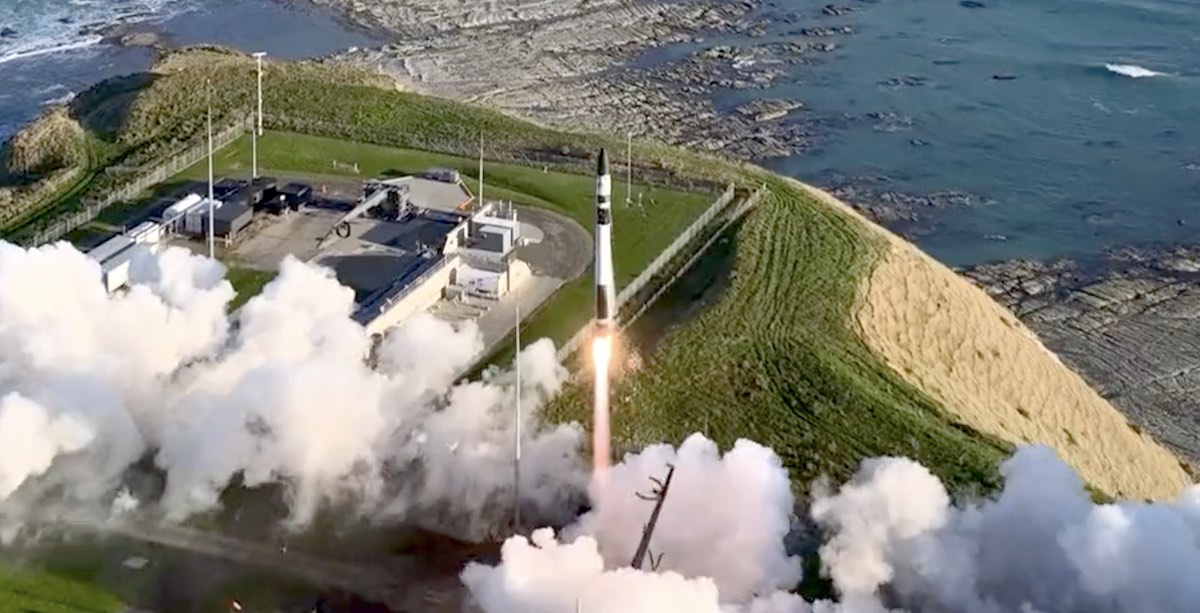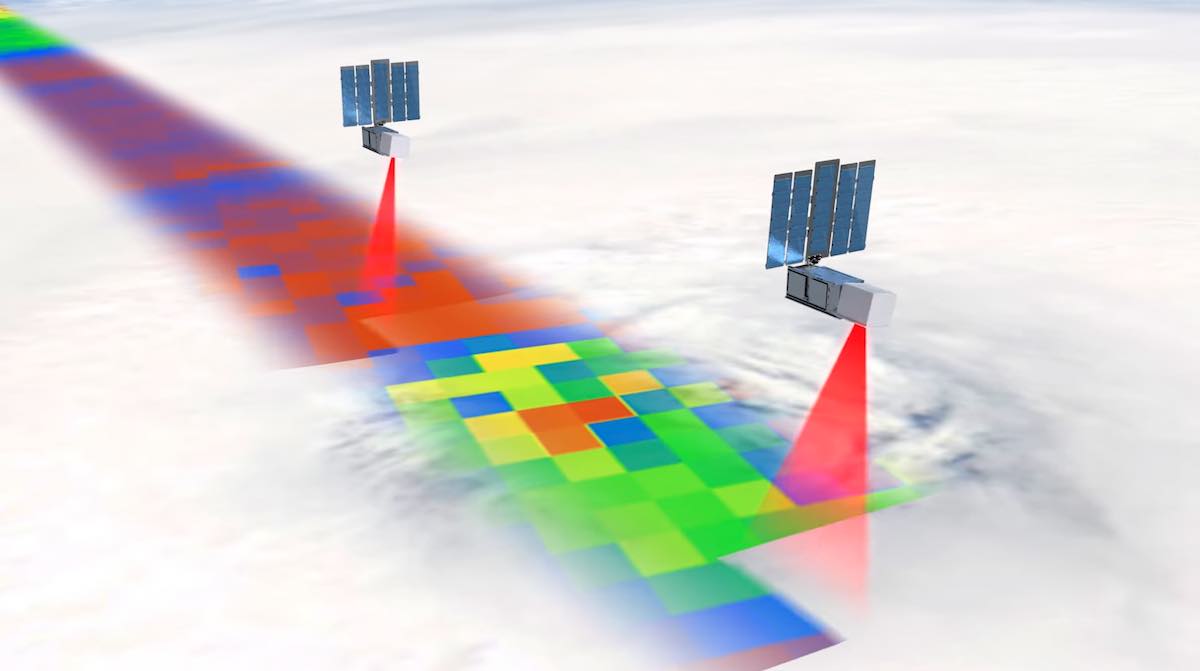Space News & Blog Articles
NASA’s final two TROPICS CubeSats launched by Rocket Lab
 Rocket Lab’s Electron launcher lifts off from Launch Complex 1B in New Zealand with NASA’s fifth and sixth TROPICS hurricane research satellites. Credit: Rocket Lab
Rocket Lab’s Electron launcher lifts off from Launch Complex 1B in New Zealand with NASA’s fifth and sixth TROPICS hurricane research satellites. Credit: Rocket Lab
The last two spacecraft in a four-satellite constellation of tropical cyclone research platforms took off late Thursday from New Zealand on a Rocket Lab Electron launcher, helping ensure NASA’s TROPICS mission is ready for observations in time for the peak of this year’s Atlantic hurricane season.
Rocket Lab’s Electron launch vehicle lifted off from Launch Complex 1B at the company’s privately-owned spaceport in New Zealand at 11:46 p.m. EDT Thursday (0346 UTC Friday). A little more than a half-hour later, the rocket’s upper stage released NASA’s final two TROPICS CubeSats into an on-target orbit about 340 miles (550 kilometers) above Earth.
The launch, which took off at 3:46 p.m. local time Friday in New Zealand, occurred almost exactly six years after the first test flight of Rocket Lab’s Electron rocket. It was the 37th Electron launch overall in Rocket Lab’s program.
NASA’s TROPICS satellites will collect imagery, temperature and moisture data over tropical cyclones. With a fleet of four operational satellites, the TROPICS mission will be capable of monitoring rapid changes in cyclones at a cadence of at least once per hour.
TROPICS stands for Time-Resolved Observations of Precipitation structure and storm Intensity with a Constellation of Smallsats. NASA selected the TROPICS mission proposal from MIT Lincoln Laboratory in a 2016 competition for funding through the agency’s Earth Venture program, a series of competitively selected, low cost Earth science missions.
The constellation was originally supposed to consist of six satellites, plus a pathfinder spacecraft that launched in 2021. But the mission architecture only needed four spacecraft to meet minimum scientific requirements. NASA and the TROPICS science team knew the mission, relying on CubeSat technology and emerging launch providers, might carry a higher risk of a spacecraft or rocket failure.
It turned out the first two TROPICS satellites were lost in a June 2022 launch failure aboard the Rocket 3 vehicle built by Astra, which had a contract for two additional launches to finish deploying the TROPICS satellite fleet.
NASA switched the launch of the final four TROPICS spacecraft to Rocket Lab, at a cost of $13 million for two launches, as Astra retired its Rocket 3 design to focus on a larger launch vehicle. Rocket Lab has a more successful track record than Astra, and the company delivered the next pair of TROPICS satellites into orbit May 7 after liftoff from New Zealand.
Liftoff of Rocket Lab’s Electron launch vehicle with the final two CubeSats for NASA’s TROPICS mission, a constellation of smallsats to study the formation and intensification of tropical cyclones. https://t.co/8OjD1LOAG6 pic.twitter.com/kpbCgFfKuZ
— Spaceflight Now (@SpaceflightNow) May 26, 2023
On Thursday night’s TROPICS mission, the nearly 60-foot-tall (18-meter) fired its nine kerosene-fueled Rutherford engines to power off the launch pad and head east from Rocket Lab’s spaceport on the North Island of New Zealand. The first and second stages of the rocket placed the two CubeSats into a roughly 340-mile-high orbit, then a kick stage fired its thruster to change the orbital inclination to angle of 32.7 degrees to the equator, giving the spacecraft regular coverage over the tropics.
The two Rocket Lab launches with NASA’s TROPICS CubeSats were originally supposed to fly from a launch site in Virginia, but Rocket Lab and NASA agreed earlier this year to move the missions to the company’s primary spaceport in New Zealand, which would enable the smallsats to fly sooner.
Each TROPICS satellite, assembled by Blue Canyon Technologies in Colorado, weighs about 11.8 pounds (5.3 kilograms). The satellites are about the size of a loaf of bread, and each craft carries a microwave radiometer instrument.
Many CubeSats ride to space on rideshare launches, allowing operators to take advantage of lower costs by bundling their payloads on a single large rocket. But the TROPICS satellites need dedicated launches to reach their precise orbital destinations.
The low-inclination orbit selected for the TROPICS mission will focus the satellite observations on hotspots for tropical cyclone development.
 Artist’s illustration of two TROPICS satellites collecting data on hurricanes. Credit: NASA
Artist’s illustration of two TROPICS satellites collecting data on hurricanes. Credit: NASA
“We’re trying to make improved observations of tropical cyclones,” said William Blackwell, principal investigator for the TROPICS mission from MIT Lincoln Laboratory, in an interview last year. “And what we’re really trying to characterize is the fundamental thermodynamic environment around the storm. So that’s things like the temperature, and the amount of moisture and precipitation intensity, and the structure around the storm.
“Those are important variables because they can be related to the intensity of the storm, and even potential for future intensification,” Blackwell said. “So we’re trying to make those measurements with relatively high revisit. That’s really the key new feature that the TROPICS constellation provides, is improved revisit of the storms.
“With these new measurements of rapidly updated imagery, we hope that that will help us understand the storm better, and ultimately lead to better forecasting of the hurricane track and intensity,” Blackwell said.
This email address is being protected from spambots. You need JavaScript enabled to view it. the author.
Follow Stephen Clark on Twitter: @StephenClark1.
When you subscribe to the SpaceZE News Feed, we will send you an e-mail when there are new updates on the site so you wouldn't miss them.

